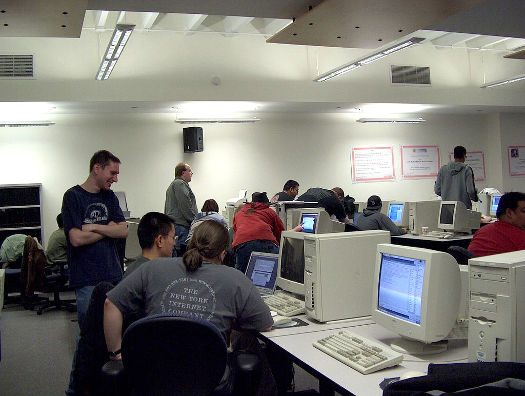In this article, for the first time since 2003 a writer makes mention of Caldera without immediately following it with a mention of SCO. Must’ve been a mistake.

MJKazin at English Wikipedia [CC BY-SA 2.5-2.0-1.0 or GFDL], via Wikimedia Commons
Ah, yes. I remember the good old days when you had to be a real man or woman to install Linux, and the first time you tried you ended up saying something like “Help!” or maybe “Mommmmyyyyy!” Really, kids, that’s how it was. Stacks of floppies that took about 7,000 hours to download over your 16 baud connection. Times sure have changed, haven’t they?
I remember Caldera advertising that their distribution autodetected 1,500 different monitors. I wrote an article titled “Monitor Number 1501,” because it didn’t detect my monitor. And sound. Getting sound going in Linux took mighty feats of systemic administsationish strength. Mere mortals could not do it. And that’s why we had installfests: so mighty Linux he-men and she-women could come down from the top of Slackware Mountain or the Red Hat Volcano and share their godlike wisdom with us. We gladly packed up our computers and took them to the installfest location (often at a college, since many Linux-skilled people were collegians) and walked away with Linuxized computers. Praise be!
Installfests were typically sponsored by Linux Users Groups, or LUGs, which were groups of Linux users. Some LUGs were big. Some were small. But they all had interesting people in them. Smart, too. It was an article of faith back in those days that Linux users were smarter than Windows or MacApple users. Was this true? Probably? Or at least most Linux users had more patience for learning strings of text commands like ungrp/.pulvrzr splish splash \\ ts-cm while users of (sniff) commercial operating systems just pointed and clicked like barbarians.
In the beginning was the command line was both an essay by Neal Stephenson and an article of faith. The only problem was, the vast majority of computer users didn’t administer their systems often enough to remember all those commands, which kept Linux from becoming popular.
There was a vociferous crowd of Linux purists who maintained that anyone who wanted to use Linux should learn how to use the command line proficiently, which sort of broke down when you realized that many people used computers as tools to help them write or practice medicine or design race cars, rather than use them as an end in themselves. So gradually, the purists realized that rather than just scratching their own programming itches, perhaps they should become a little less self-centered and scratch the itches of their coworkers, parents, and even girlfriends.
Girlfriends? What an idea! And it worked. (The late) Joe Barr, who wrote the article linked to in the last paragraph, actually became socialized enough that he not only hooked up with a lovely woman named Susan, but got her to marry him. Many other all-night hackers and command-liners also realized that there was life beyond their screens (and LUG meetings), and ended up married and even — in some extreme cases — reproducing.
While the geeks danced, installfests died out
Even as the old Linux types became professional (and well-paid) IT workers and programmers, bought cars, and started spending their nights in night clubs with people of the opposite (or in some cases, the same) sex and developed social lives, Linux got pretty easy to install. Not only that, but some of the smarter computer users figured out that if they wanted to run Linux, instead of sticking Linux discs into random PCs and hoping everything would work, they could actually choose computers and components known to work with Linux in the first place. So no more installfests.
And without installfests, there was a lot less need for LUGs. Oh, plenty still exist, but their email lists or IRC channels are often more active than the F2F meetings, and the LUGs are now composed primarily of computer professionals giving and receiving technical help — and people who enjoy each other’s company of course, because Linux users still tend be be both smart and interesting
Robin “Roblimo” Miller is a freelance writer and former editor-in-chief at Open Source Technology Group, the company that owned SourceForge, freshmeat, Linux.com, NewsForge, ThinkGeek and Slashdot, and until recently served as a video editor at Slashdot. Now he’s mostly retired, but still works part-time as an editorial consultant for Grid Dynamics, and (obviously) writes for FOSS Force.







I see that the photo is from 2005. By that time installing Linux was getting pretty mushy. I even moved away from Mandrake/Mandriva and it was still a very easy install.
Everybody likes to make fun of the fact that 2004 was called “The year of the Linux desktop”, but the fact is that it was the year when the average desktop user could install Linux without any problems.
As for University days, by 1999 all the students have been moved to Linux and by 2001 the last and most reluctant prof. Good old days …
I really need more time to play with Slackware, but I think a lot of the geeks of old, finally did the old man woman thing.
It might be a good idea to start have an installfest two or three times a year…if for no other reason than for those that would like an alternative to the Windows 10 spyware/malware/virus!
I remember those days well. My LUG was actually a UNIX users group, so we had pro users who also experimented with Linux. Failing to get dial-up working was what got me to that first meeting and helping at the monthly install-fests kept me going back. I was slightly less geeky than my piers, already being married with kids. Because I had a flair for writing, I snagged an early gig writing for MaximumLinux and then for LinuxFormat. It was with mixed emotions that I saw Linux become easy to install and configure and support a wide range of hardware. I have not compiled a kernel in a decade. Modern Linux is awesome, but it’s not as much fun anymore.